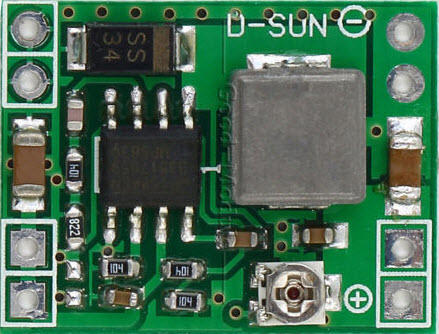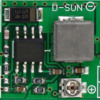I've been batting this idea around for some time, and decided I'd take a stab at making my own variable AC-DC power supply that included stuff like DCS compatibility, as well as common ground capability for compatibility with TMCC systems. I frequently want an independent source of power in projects, this seems to be a good way to solve that problem. Here's the result of my thinking, it's simple and to the point. I use one of the many Chinese small switching modules as my switching power supply base and just add the DCS choke, input rectification, and filtering for the switching module. I did an initial design with one large capacitor and the DC-DC module on top, but that ended up making the board larger than it needed to be with wasted space. I get the same amount of filter capacitance with two smaller capacitors, and the whole board sandwich ends up being quite a bit smaller. Having the smaller capacitors allowed me to put the DC-DC module under the main board and still have access to the voltage control pot.
In testing the DC-DC module, I discovered that under load the component that gets the hottest is the small ferrite encased coil. Conveniently, it's also the tallest part on the board. In an effort to provide a bit more thermal heat dissipation, I use a copper pour on the board that will sit on top of the module to spread the heat. The module will be bonded to the bottom of the board with thermal adhesive to promote heat transfer. The top PCB has connections that match the connections on the DC-DC switching module, jumpers will go between the two boards to connect them and to provide structural support. A hole is provided in the upper board to allow access to the voltage adjustment pot of the DC-DC switching module.
Here's a schematic and the PCB layout of the board, placed an order for prototypes, it'll be interesting to see how this works out. I should be good for several hundred milliamps of current, I haven't tried to push it to see how much I could get out of it.
































